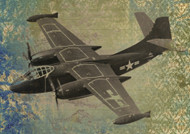The Age of Aerospace: 100 years of Aviation History
By on May 11th 2016
Remembering the Roots of Modern Aviation

In case you haven't already heard, Boeing is celebrating their
centennial anniversary this year.
Since July 15, 1916, Boeing has been shaping the history of aviation as we know it today. From the single wood and canvas airplanes of the past, to the space travel technologies of today, The Boeing Company has survived through war and peace and the uncertainty of the future to become the world's largest aerospace company--with promises of making the future bright and full of continued innovation.
The Age of Aerospace recounts and pays tribute not only to the past and fate of Boeing and the company's people, but also the contributions to technology, culture, and history. This five film series explores in detail the past 100 years of aviation history, from the Wright brothers' first flight to the Apollo moon landings and beyond, highlighting the biggest milestones "in an industry defined by innovation."
Unfortunately, today (May 11) is the last chance to watch the series TV broadcast in in the US (which aired 9 am EST on the Science Channel); however, the entire series is available for streaming online
here, and features additional bonus content, 18 language options, as well as an interactive library arranged by episode. The interactive library provides historical information, links to further reading, and photo galleries of relevant historical images.
To celebrate the history of aviation, we have provided a basic breakdown of information as outlined in the first film in the series, What Can't We Do?
What Can't We Do?
The first episode (the pilot, if you will) highlights how Bill Boeing, Donald Douglas, James McDonnell, and their contemporaries turned the airplane into an industry, making remarkable advancements in communication, transportation, and warfare.
Evolution of Early Airplanes
- Trace the early development and evolution of the airplane, starting with the Wrights' first successful flight at Kitty Hawk, NC, on 17 December 1903.
- The de Havilland DH-4 (dubbed the "Liberty Plane") evolved from an all-wood plane covered in stretched fabric (from its first flight in 1916), to an aircraft built using steel. This 2-seater bomber was the only US-built aircraft to see combat during WWI.
- The Boeing Model 40 (first flight 20 may 1927) was built to transport mail, but was also the first plane built with an enclosed cabin to transport passengers, as well.
- The Boeing Model 80A (introduced 14 months after the Model 40), was new in terms of passenger numbers (12 originally then later 18), comfort, and its enclosed cockpit (protecting pilots from the elements).
- The Douglas DC-3 is often considered the first commercially successful airliner, and although production stopped in 1945, the DCs are still used today.

Air Mail
- In the early years of aviation (before commercialization really took flight), government-sponsored airmail became the predominant means for aircraft manufacturers to financially support their industry.
- The first scheduled airmail service was established May 1918 between New York and Washington, D.C. Soon after a transcontinental route developed from New York to Cleveland, Cleveland to Chicago, Chicago to Omaha, and by September 1920, Omaha to San Francisco.
- Complications regarding the delivery of mail ultimately led to airplane manufactures having to split from the airlines they operated and gave the federal government the responsibility for decisions on rates, safety, and contracts.

Aerial Warfare WWI
- World War I was the first instance of widespread use for airplanes as weapons of war.
- Initially used to aid in scouting and photography, it didn't take long for people to begin shooting each other from them.
- Innovation in aviation technology was directly influenced by the the desire to maintain an upper hand over adversaries during war.
- Five distinct generations of aircraft development occurred during The Great War:
- First Gen: Mostly modified prewar designs with modifications to accommodate machine guns
- Second Gen: Designed to feature armaments from the outset (first appeared Spring 1915).
- Third gen: More powerful than predecessors, more streamlined to reduce drag, and many featured twin forward-facing machine guns synchronized to fire through propeller (Spring/Summer 1916).
- Fourth Gen: Increased climbing capability and speed; more readily to the defensive flying required in dogfights.
- Fifth Gen: largely of all-metal construction and monoplane design with a single deck of wings (appeared shortly before the end of WWI).

Air Shows
- "Early air shows captured the imagination of Americans and spurred a new generation of aviators."
- Reims Air Meet in August 1909 (France) was the first of its kind; shortly followed by 3 airshows in 1910 in LA, Boston, and New York.
The First Stewardesses
- Ellen Church became the first female flight attendant in the late 1920s: a registered nurse and a licensed pilot, Church could not get a job as a pilot because airlines didn't hire women. Instead, Church suggested the idea of female flight attendants.
- S.A. Stimpsons (of Boeing Air) championed the idea and allowed Church to recruit 7 other stewardesses for a 3 month trial period. It was an instant success.
- Requirements for being a stewardess: she could be no taller than 5'4", weigh less than 125 pounds, be single, and 25 years-old or younger.
Episode 1 only covers a very brief (yet extremely important) timeline in tracing aviation innovation. To learn more, you can check out the four other episodes of The Age of Aerospace for yourself:
Miracle Planes
Details the role American industry and airplanes played in the Allied victory over Germany and Japan.
We Have Shrunk the Earth
Explores the planes that launched the
jet age: B-47 Bomber, Boeing 707 and 747 Jumbo Jet, which were all made possible by secrets discovered in a German Forest at the end of WWII.
In the Vastness of Space
The story of Project Apollo and discussions on humanity's future in space.
Dreamliner
Understanding the technology, resources, and risks required to build modern commercial aircraft (through the 787 Dreamliner).

The technological advances in the aviation industry have skyrocketed over the past century; if history can tell us anything, it's probably that the potential for air travel can only go up exponentially from here.







